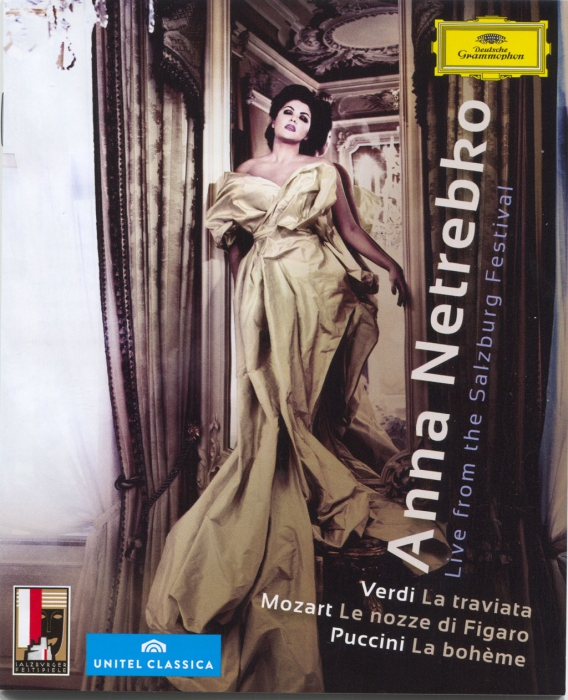
At the time of the earliest performance in this Netrebko Salzburg trilogy, the soprano was perhaps best known in the lyric coloratura bel canto repertoire. It could be that she reached her apotheosis in this genre in her performance as Elvira in Bellini’s I Puritani at the Met in 2007 where the combination of her singing and acting in the mad scene is outstanding (review). Young and slim, she moved and acted with total commitment as she announced herself in the performance of La Traviata included here. She matched Villazón’s renowned acting, movement for movement. As the years passed, and particularly after her pregnancy, her voice grew in size and colour. As of 2014 opera-lovers are waiting on her assumption of Leonora in Verdi’s La Forza del Destino, particularly after her singing of the same named role in Trovatore in Berlin in 2013 (review). The latter surpassed her 2012 performance of Mimi in Puccini’s La Bohème included in this collection. Reports of her assumption of Verdi’s Lady Macbeth at New York’s Metropolitan Opera in Autumn 2014 are also awaited.
As this collection shows, her voice was already maturing as she sang Susanna in 2006. Her voice was mature and lyric in respect of flexibility and colour and this was matched with her capacity for characterisation. Her vocal maturation had its hiccups as I noticed in the Met broadcast of Lucia di Lammermoor in February 2009. The tone had thickened and she was not as steady as previously, a state of affairs that was also evident in her assumption of the soprano role in Rossini’s Stabat Mater in 2010 (review). This characteristic was further confirmed by listening to a broadcast of Carmen from Vienna recorded earlier in 2010 when her Micaela was distinctly insecure complete with an obvious vibrato. There are ups and downs for all singers as their voices change with age, experience and in the case of some women, pregnancy.
All the stagings from Salzburg in this collection are challenging in varying degrees. All are updated in respect of costume and sets. However, in at least the Puccini and Verdi, if not in the Mozart, the spirit of the composer’s creation is maintained in the productions.
La Traviata
Bonus: interviews and rehearsals.
Violetta Valery – Anna Netrebko (soprano); Flora – Helene Schneiderman (mezzo); Annina – Diane Pilcher (soprano); Alfredo Germont – Rolando Villazón (tenor); Giorgio Germont – Thomas Hampson (baritone); Gastone – Salvatore Cordella (tenor); Doctor Grenvil – Luigi Roni (bass); Baron Douphol – Paul Gay (baritone); Marquis d’Obigny – Herman Wallén (baritone); Giuseppe – Dritan Luca (tenor)
Chorus of the Vienna State Opera
Vienna Philharmonic Orchestra/Carlo Rizzi
rec. live, Grosses Festspielhaus, August 2005
Staged and Directed: Willy Decker
Video Director: Brian Large
Subtitles: English, German, French, Italian, Spanish, Chinese
Picture format: 1080i HD 16/9
Sound Formats: DTS HD Master Audio 5.0; LPCM Stereo. DTS 5.1
[132:00 + bonus: 47:00]
The Salzburg setting by Willy Decker accentuates the starkness of the story of the heroine’s travels and travails. Apart from Violetta’s scarlet dress during her courtesan episodes, the only colours are the coverings of the settees in the young lovers country abode and the dressing gowns they wear as they cavort, kiss and fondle each other in the flush of their love. At other times the settees are stark white as is the curved cyclorama and the plain stone-like seat that fills its arc. Then there is the clock: large, white-faced with stark black figures and fingers. Its keeper, white-haired and bearded in a black greatcoat, later turns out to be Dr Grenvil who periodically stalks the stage, or moves the clock fingers. In act 3 he cannot answer Violetta’s pleas for life when she realises Alfredo is returning to her and really loved her after all. As the watcher of Violetta’s remaining time on earth, the keeper of the clock gives Violetta a white flower when periods of true love intrude. When pressures and her existence demand other directions she dons her scarlet dress. The chorus are all dressed in black and when not looking down from over the cyclorama enter and move around like a shoal of fish, the odd member peeling off to sing the comprimario lines. This simple stark staging is meant to illustrate the bleakness of the outcome. Devoid of fripperies and distractions it succeeds to a disturbing degree. This staging is intent on being more than a setting of an operatic story involving vocal display. In its starkness it aims to tell the harrowing and bleak story of young lives in a period of gross social inequality and dubious morality.
Such a staging requires singing actors of considerable ability in order to bring out the agonies and all too brief ecstasies of the story. In two of the three principal roles, Netrebko as Violetta and Rolando Villazón as Alfredo, it has them. Both are animated stage creatures of considerable acting and singing skills. She looks wonderful and acts the part of a nubile and love-lorn young woman who subliminally knows her ultimate fate. Yes, she does find some difficulty in the vastly different demands Verdi makes of his eponymous heroine in the different acts, particularly act 1 compared with acts 2 and 3. Add the physical demands Willy Decker makes on Netrebko and her achievement is even more significant. There is some recognition of this in the omission of second verses in the final scene of act 1 (Chs. 7-10) when she also eschews the interpolated high B flat.
Whilst the divisions of Netrebko’s coloratura are less than perfect her vocal expressiveness in act 1 is superb and wholly illuminates Violetta’s changing moods. However, her most expressive singing and lovely legato are kept for Teneste la promessa and the reading of Alfredo’s letter (Ch. 34). Her vocal nuance in this scene is immensely moving. Sadly, the last scene leading to Violetta’s death left me curiously dry-eyed. Violetta’s presenting of her portrait to Alfredo in Prendi, quest’e l’imagine (Ch. 39) with the request that he give it to a future virgin wife, passed with barely a notice by Decker. Yet this is one of the most poignant moments in all opera. Likewise Violetta’s lying on the now horizontal clock-face was no substitute for a bed or couch; nor was the removal from the stage of the clock as a precursor to her death. This final scene, as with the gypsy’s dance and Alfredo’s throwing money at Violetta and being disowned by his father, is not well handled by the director nor is it given the up-front focus required. In a production less physically demanding, and surrounded by a less stark setting, Netrebko had at that time the vocal and histrionic skills to give a memorable Violetta. As it was her interpretation is nearly, rather than actually, great.
Villazón’s characterisation of Alfredo’s changing mood as the realisation of their financial position, and Violetta’s sacrifice, is conveyed by vocal artistry of the highest order. Also impressive is his ability to vary the tonal weight of the voice he brings to the changing and varied dramatic situations of the role. These range from the brio of the act 1 Brindisi (Ch. 4) through the anger and drama of the meetings with his father (Chs. 23 and 31) to sheer beauty of phrasing and vocal expression in the duet Parigi o cara (Ch. 36). In my original review I suggested that with good self-management his would be a long and distinguished career marked by a rare combination of fine singing paired, as it so rarely is among tenors in particular, with really great acting skills. For better or worse the reality has been different although he is now back singing some of the repertoire he should never have left.
Carlo Rizzi’s brisk conducting of the first two acts suits the stark staging and, at times, frenetic activity. He slows down for the last act. This should have allowed Netrebko the better to convey the emotional roller-coaster of the final episodes. As I have indicated above, the final scene didn’t pull my heart-strings as they are by Pier Luigi Pizzi’s modern dress Madrid staging with Norah Amsellem’s well acted and sung Violetta (see review) and by Angela Gheorghiu on the Decca DVD of the 1994 Covent Garden production by Richard Eyre. Willy Decker’s staging overcomes many self-inflicted incongruities to convey something of the tortured soul of this story, but he loses his way in the last act. For me that entails a failure of Verdi intentions and of the whole reality of his portrayal of Violetta’s tragic and emotionally tortured life.
Le Nozze di Figaro
Susanna, maid to the Countess – Anna Netrebko (soprano); Figaro, manservant to the Count – Ildebrando D’Arcangelo (bass-baritone); Count Almaviva – Bo Skovhus (baritone); Countess Almaviva – Dorothea Röschmann (soprano); Cherubino, a young buck around the palace – Christine Schäfer (soprano); Marcellina, a mature lady owed a debt by Figaro – Marie McLaughlin (soprano); Don Basilio, a music master and schemer – Patrick Henckens (tenor); Don Bartolo – Franz-Josef Selig (bass); Antonio, the Count’s gardener – Florian Boesch (baritone); Barbarina, his daughter – Eva Liebau (soprano)
Chorus of the Vienna State Opera
Vienna Philharmonic Orchestra/Nicholas Harnoncourt
Stage director: Claus Guth
Stage and Costume design: Christian Schmidt
rec. live, Haus für Mozart, Salzburg, July-August 2006
Subtitles: Italian (original language), English, German, French, Spanish
Video Director: Brian Large
Sound Format: LPCM Stereo, PCM 5.1
Picture Format 16:9.
[202:00]
This production of Le Nozze di Figaro, in the two hundredth and fiftieth anniversary year of Mozart’s birth, heralded a year when the Salzburg Festival was intent on staging all his operatic creations, even the juvenilia. It offered this production of what is arguably Mozart’s greatest operatic work to Claus Guth who also later staged the other two parts of the Mozart-Da Ponte trilogy at the Salzburg Festival: Don Giovanni in 2008 and Cosi fan Tutte in 2009. Neither of them was orthodox with Nicholas Harnoncourt on the rostrum not particularly following tradition as to tempi either. The opera was performed in the previously known Kleines Festspielhaus which emerged, after an extensive renovation in 2006, as Haus Für Mozart, one of the three operatic venues used by the festival: the others being the Grosses Festspielhaus and Felsenreitschule.
This opera, including the act four Garden Scene, is set inside a late-nineteenth century mansion dominated by a wide staircase. In an opera of five principal roles and as many lesser but significant ones, the Director introduces a further character in the form of an Angel, Cherubim. Complete with wings he flutters about the stage and among the singers. If I had been concentrating on my acting and singing and the complex interactions involved in the plot, I would have taken my vocal chords home. Mozart doesn’t need such distractions from his divine music or Da Ponte from the superb libretto he provided for Mozart.
Whilst Don Giovanni is described as Giocoso, serious with lighter moments, Figaro has always been described as a buffa or comic opera. Not so in this production, with a count who is more than seriously intent on having Susanna on her wedding night and seems to be in a fevered brow-sweating state in his intentions for most of the opera. As portrayed by Bo Skovhus he is a nasty piece of aristocracy, his singing strong and secure, his modern dress dinner suit exemplifying his social status. As Figaro, his servant-cum-incipient-revolutionary, Ildebrando D’Arcangelo is superb in his singing and acting as he manipulates the plot and characters in a manner APPropriate to a buffa work. This is particularly noticeable in his relationship with the ladies, in reality and in travesti, the latter referring to Christine Schäfer’s flexible-toned soprano rather than the usual mezzo. She sings the role of Cherubino superbly, albeit that in short trousers she hardly looks the hormone-driven adolescent. Dorothea Röschmann is a renowned Countess. Whether troubled by Harnoncourt’s slow tempi, or the general nature of the production, her cavatina Porgi amor (Ch.22) at the opening of act two, lacks conviction and ideal steadiness. She quickly improves and well before Dove sono (Ch.49) she is up to standard. Netrebko’s Susanna, costumed as one might find a waitress in a good restaurant not long ago, is distinctly fuller-toned than normal. She acts well, but I found her singing lacking in conviction, not normally a state of affairs i associate with her; I have always found that she has natural facility for portraying characters. However, she manages to escape the general malaise to sing an unusually well-toned Deh vieni (Ch.66), full of pathos and yearning. Was she, as well as I, not wholly convinced by Harnoncourt’s variable, often turgid tempi, and over-serious approach to this opera?
With this all-round strong singing cast, I finished my viewing in frustration at both the production, sets and conducting. It is the first time I have finished a performance of Mozart’s divine work, whose tunes normally rattle round my head for days after, in such a mood; I wondered if I had been missing something all these years. My mind harked back to leaving a performance of Calixto Bieto’s Merry Widow and going home to watch a video of Carlos Kleiber’s performance to clear my palate. Beaumarchais might have written an anti-establishment play, but Mozart wrote a comic opera that should scintillate in performance, not stagnate and frustrate with additional angels.
La Bohème
Rodolfo – Piotr Beczala (tenor); Mimi – Anna Netrebko (soprano); Marcello – Massimo Cavalletti (baritone); Musetta – Nino Machaidze (soprano); Schaunard – Alessio Arduini (baritone); Colline – Carlo Colombara (bass); Alcindoro – Peter Kálmán (tenor); Benoit – Davide Fersini (bass); Parpignol – Steven Forster
Chorus of the Vienna State Opera
Salzburg Festival Children’s Chorus
Vienna Philharmonic Orchestra/Danielle Gatti
rec. live, Grosses Festspielhaus, July-August 2012
Stage director: Damiano Michieletto
Set and Stage Designer: Paolo Fantin
Costume Designer: Carla Teti
Video Director: Brian Large
Picture format: 1080i HD 16/9
Sound Formats: DTS HD Master Audio 5.1. 5.0
Subtitles: English, German, French, Italian, Spanish, Chinese, Korean
[124:00]
This updated version could be seen as the ultimate in Regietheater opera: deconstructed and then rebuild in a near unrecognisable setting and with updated costumes. Hang the words, as when Mimi talks of revealing an ankle when she is wearing a mini-skirt, leather jacket and fishnet tights. The set of act one is a vast apartment with what must look like the largest picture window in Paris, looking out on a walkway; not much privacy for a bit of canoodling with these sized windows and passers by. The apartment has sparse furnishing: the stove heated from a gas bottle and a supermarket trolley are part of the general clutter. Act two is laid out on a street map of Paris. No Café Momus, just, eventually, a few model buildings. The act three set has snow, a very steep road and a burger stall. Customs officers appear briefly, but you could miss them. A back-alley behind the burger stall conceals Mimi as she overhears Rodolfo explain to Marcello his worries that she is dying. Act four is back in the garret with a hastily made-up bed when Musetta brings the sick Mimi back. The so-called pink bonnet that Rodolfo bought Mimi in act two, in fact a trilby, hardly looks as if it has been kept under a pillow.
It is not often that Puccini gets a look-in at the Salzburg Festival these days and with Anna Netrebko in the cast they could gainfully have given her a better visual framework to portray her vocal wares and acting ability. Her voice, now much larger than in her bel canto days, and with a warm centre, makes her an ideal Mimi. She has an innate ability to act with conviction and bring a role to life whatever the circumstances or quirks of the setting. As her would-be lover, and later cohabitee, Piotr Beczala looks like a geek in his specs and seems as much interested in his film movie camera as in poetry although he does have enough paper to burn in an improvised bucket. His voice lacks much in the way of Italianata and his open-throated singing can become tiring, lacking in variation of colour. Of the other habitués of the garret, Massimo Cavalletti’s Marcello is the most vocally appealing and his duet with Rodolfo a performance highlight. Alessio Arduini is a rather camp Schaunard, but vocally secure, whilst Carlo Colombara as Colline was more secure vocally in his lower register than ascending. Nonetheless his farewell to his overcoat was well sung. Nino Machaidze’s Musetta is sparky and characterful if strained at the very top of her voice. On the rostrum Danielle Gatti’s tempi are very variable and trouble the soloists from time to time.
Some years ago, Welsh National Opera conceived of an interesting marketing strategy when they sent ticket purchasers of performances of La Bohème a packet of paper handkerchiefs to arrive by post the following day. Well, the death of the young consumptive Mimi can be emotional, not merely because she dies so young, but just as Verdi did in La Traviata forty-three years before, Puccini invests the death scene with some of his most poignant melodies and motifs. I have seen both operas many times and the conclusion generally leaves me with a lump in my throat and often the use of my handkerchief. This production’s unimaginative management of Mimi’s death-scene left me without even a lump in my throat.
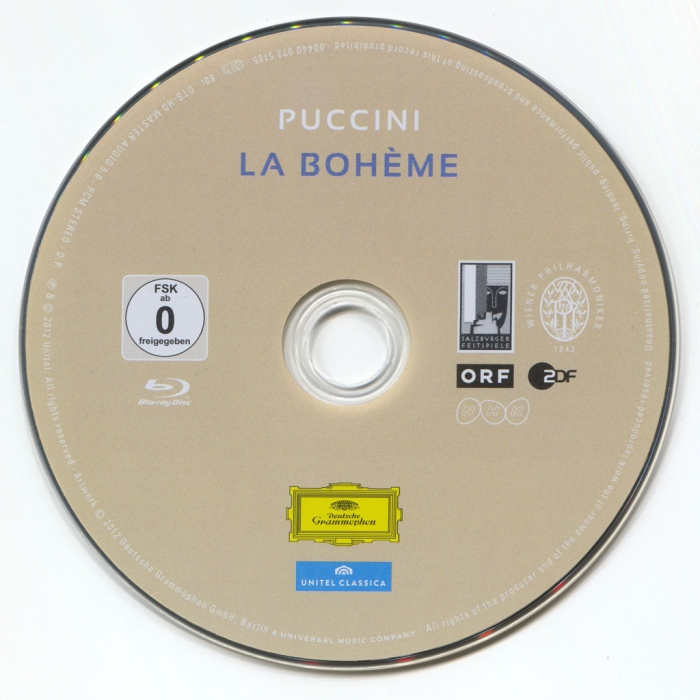
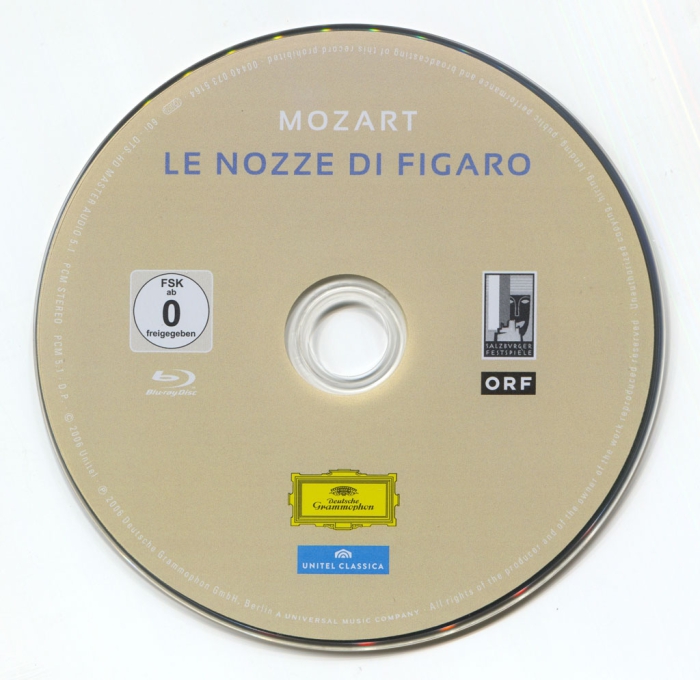
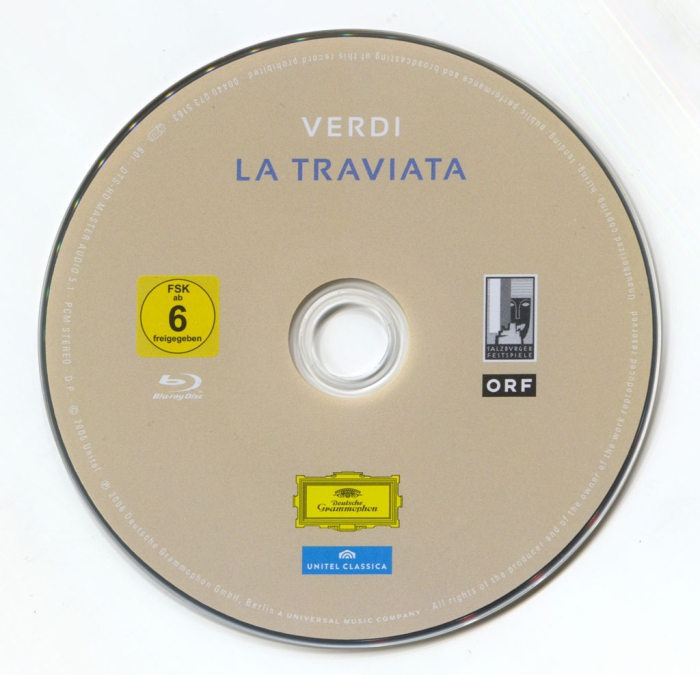
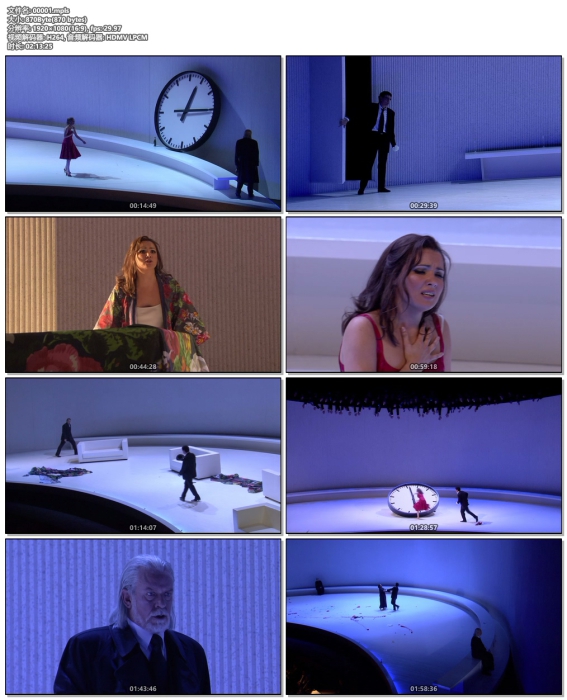
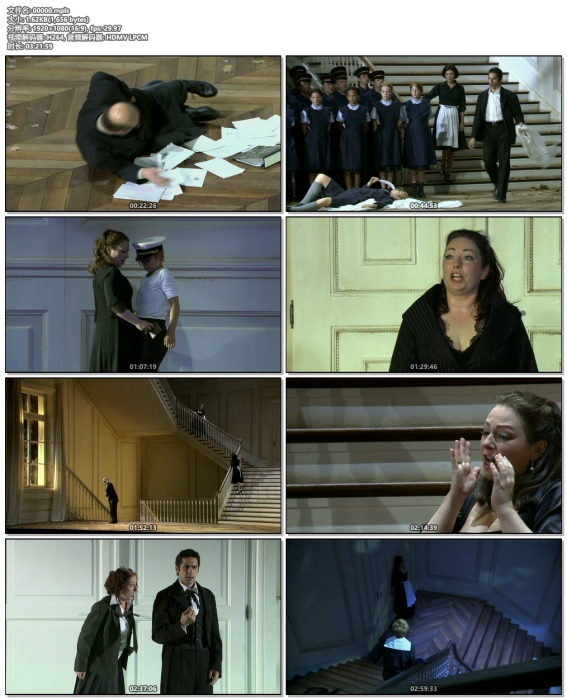
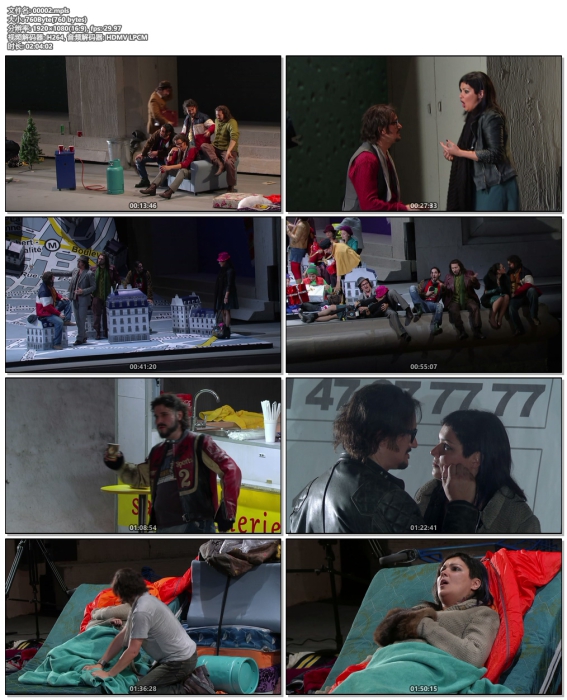

![[BD欧美演唱会][Anna Netrebko – Live From The Salzburg Festival (2014) 3 x Blu-Ray][BDMV 3BD][110G][百度网盘]](https://xiaohuohu.com/wp-content/uploads/2023/11/1701244256-c4ca4238a0b9238-300x200.jpg)
![2013《金秋喜临门》[汉语普通话/全1集5.2G][百度下载]](https://xiaohuohu.com/wp-content/uploads/2024/11/1732264250-a2cdaf92cfb560d-270x200.jpg)
![2003《蒸发疑云》[汉语普通话/全1集4.42G][百度下载]](https://xiaohuohu.com/wp-content/uploads/2024/11/1731820038-7ca796e751ce171-270x200.jpg)
![2016《警察“夏一笑”的快乐生活》[剧情/喜剧][汉语普通话/全1集4.42G][百度下载]](https://xiaohuohu.com/wp-content/uploads/2024/11/1730744470-f334eb196986a03-270x200.jpg)
![[BD欧美演唱会][平克·弗洛伊德 Pink Floyd – P. U. L. S. E. Live at Earls Court 1994 (2022)][BDMV 2BD][62.3GB][百度网盘]](https://xiaohuohu.com/wp-content/uploads/2024/07/1721013777-3c7d3bb853fead0-300x200.jpg)